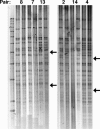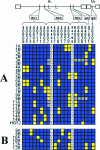Sequence-based methods for identifying epidemiologically linked herpes simplex virus type 2 strains
- PMID: 16825377
- PMCID: PMC1489507
- DOI: 10.1128/JCM.00054-06
Sequence-based methods for identifying epidemiologically linked herpes simplex virus type 2 strains
Abstract
Traditional methods for confirming the identity of herpes simplex virus (HSV) isolates use restriction fragment length polymorphism (RFLP). However, RFLP is less amenable to high-throughput analyses of many samples, and the extent to which small differences in RFLP patterns distinguish between different viral strains remains unclear. Viral HSV type 2 (HSV-2) DNA isolates from 14 persons experiencing a primary HSV-2 infection and from their sexual partners were analyzed by RFLP and heteroduplex mobility assays. We also compared the HSV-2 sequences from seven regions, including noncoding regions between UL19 and UL20, UL24 and UL25, UL37 and UL38, and UL41 and UL42 and coding segments of the gC, gB, and gG genes. Although the resulting RFLP patterns of the couples were almost identical, minor banding differences existed between the source and susceptible partners in five couples. Heteroduplex mobility assays were unable to distinguish between unrelated strains. Overall, 22 sites of sequence variation were found in 1,482 bp of analyzed sequence. The DNA sequences differentiated between all unrelated infections, and epidemiologically related isolates had identical sequences in all but two pairs. Our results suggest that a multilocus assay based on several DNA sequences has the potential to be an informative tool for identifying epidemiologically related HSV-2 strains.
Figures



References
-
- Barlow, K. L., J. Green, and J. P. Clewley. 2000. Viral genome characterisation by the heteroduplex mobility and heteroduplex tracking assays. Rev. Med. Virol. 10:321-335. - PubMed
-
- Bowden, R., H. Sakaoka, P. Donnelly, and R. Ward. 2004. High recombination rate in herpes simplex virus type 1 natural populations suggests significant co-infection. Infect. Genet. Evol. 4:115-123. - PubMed
-
- Buchman, T. G., B. Roizman, and A. J. Nahmias. 1979. Demonstration of exogenous genital reinfection with herpes simplex virus type 2 by restriction endonuclease fingerprinting of viral DNA. J. Infect. Dis. 140:295-304. - PubMed
Publication types
MeSH terms
Substances
Associated data
- Actions
- Actions
- Actions
- Actions
- Actions
- Actions
- Actions
- Actions
- Actions
- Actions
- Actions
- Actions
- Actions
- Actions
- Actions
- Actions
- Actions
- Actions
- Actions
- Actions
- Actions
- Actions
- Actions
- Actions
- Actions
- Actions
- Actions
- Actions
- Actions
- Actions
- Actions
- Actions
- Actions
- Actions
- Actions
- Actions
- Actions
- Actions
- Actions
- Actions
- Actions
- Actions
- Actions
- Actions
- Actions
- Actions
- Actions
- Actions
- Actions
- Actions
- Actions
- Actions
- Actions
- Actions
- Actions
- Actions
- Actions
- Actions
- Actions
- Actions
- Actions
- Actions
- Actions
- Actions
- Actions
- Actions
- Actions
- Actions
- Actions
- Actions
- Actions
- Actions
- Actions
- Actions
- Actions
- Actions
- Actions
- Actions
- Actions
- Actions
- Actions
- Actions
- Actions
- Actions
- Actions
- Actions
- Actions
- Actions
- Actions
- Actions
- Actions
- Actions
- Actions
- Actions
- Actions
- Actions
- Actions
- Actions
- Actions
- Actions
- Actions
- Actions
- Actions
- Actions
- Actions
- Actions
- Actions
- Actions
- Actions
- Actions
- Actions
- Actions
- Actions
- Actions
- Actions
- Actions
- Actions
- Actions
- Actions
- Actions
- Actions
- Actions
- Actions
- Actions
- Actions
- Actions
- Actions
- Actions
- Actions
- Actions
- Actions
- Actions
- Actions
- Actions
- Actions
- Actions
- Actions
- Actions
- Actions
- Actions
- Actions
- Actions
- Actions
- Actions
- Actions
- Actions
- Actions
- Actions
- Actions
- Actions
- Actions
- Actions
- Actions
- Actions
- Actions
- Actions
- Actions
- Actions
- Actions
- Actions
- Actions
- Actions
- Actions
- Actions
- Actions
- Actions
- Actions
- Actions
- Actions
- Actions
- Actions
- Actions
- Actions
- Actions
- Actions
- Actions
- Actions
- Actions
- Actions
- Actions
- Actions
- Actions
- Actions
- Actions
- Actions
- Actions
- Actions
- Actions
- Actions
- Actions
- Actions
- Actions
- Actions
- Actions
- Actions
- Actions
- Actions
- Actions
- Actions
- Actions
- Actions
- Actions
- Actions
- Actions
- Actions
- Actions
- Actions
- Actions
- Actions
- Actions
- Actions
- Actions
- Actions
- Actions
- Actions
- Actions
- Actions
- Actions
- Actions
- Actions
- Actions
Grants and funding
LinkOut - more resources
Full Text Sources
Other Literature Sources
Medical
Miscellaneous

